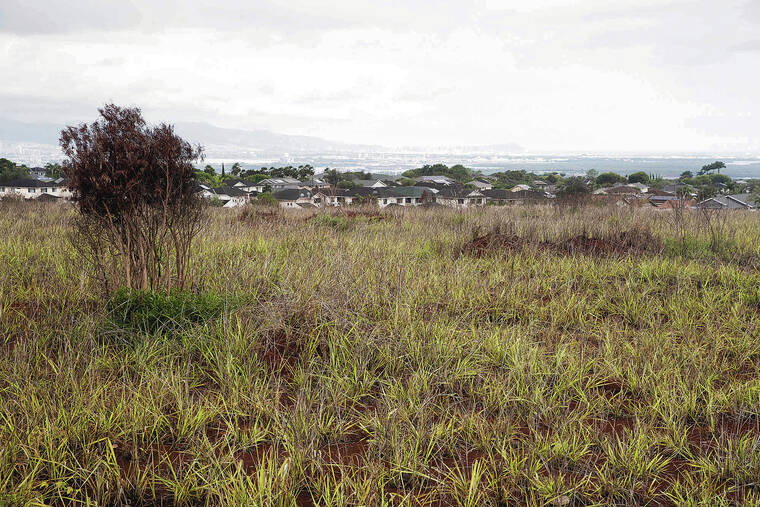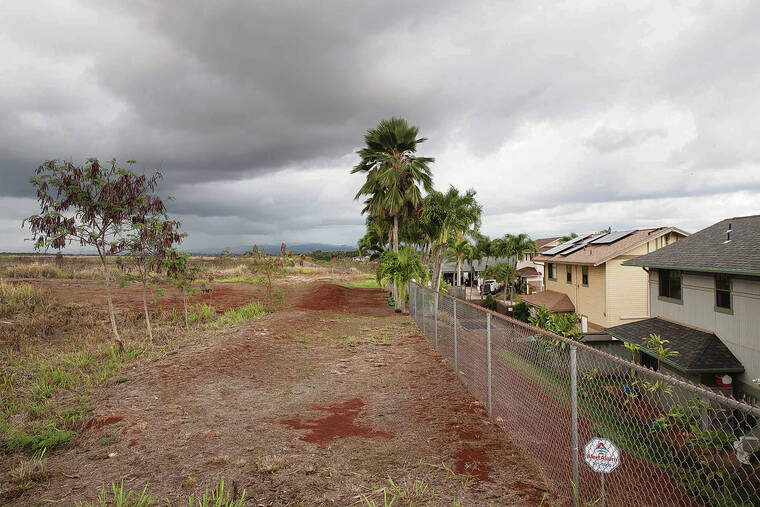A long-undeveloped second phase of
Oahu’s Royal Kunia subdivision could become Hawaiian homesteads under a plan that also includes possibly converting adjacent farmland for the same use.
The state Department of Hawaiian Home Lands wants to buy 211 acres approved for housing in Kunia for about
$60 million from developer Haseko (Hawaii) Inc. with a preliminary development agreement to produce 1,200 residential lots for beneficiaries, including 500 lots in an initial increment where infrastructure already exists.
Developing another 700 house lots on the parcel would require an investment in infrastructure up to $100,000 per lot, or about $70 million, according to the agency.
If the land acquisition happens, DHHL officials see potential to acquire adjacent land zoned for agriculture from other owners with the idea to use the agency’s zoning exemption authority to
develop more housing and dramatically reduce a backlog of roughly 11,000 beneficiaries on a waitlist for homesteads on Oahu.
Kalani Fronda, acting DHHL land development division director, presented the plan to the Hawaiian Homes Commission Monday as part of the latest proposed revision to the department’s plan to spend $600 million appropriated by the state Legislature in 2022 through Act 279, also known as the Waitlist Reduction Act.
DHHL has a statewide waitlist of roughly 28,700 beneficiaries seeking homesteads, including many who have been waiting for decades. More than 2,000 applicants also have died while on the list, according to an analysis by the Honolulu Star-Advertiser and ProPublica.
Beneficiaries, who must be at least half Native Hawaiian, can receive homestead lots under renewable 99-year leases for $1 a year but must pay for their own home.
Fronda said a permitted interaction group authorized by the commission recommends paying for the Kunia land by reallocating Act 279 funds the agency previously directed to other homestead development projects.
“Act 279 has provided the department with unprecedented resources to reduce the waitlist,” Fronda told the commission. “However, with finite funds and a growing need for immediate housing, the permitted interaction group identified an opportunity to accelerate progress through resource allocation and prioritization of readiness. … Acquisition of Kunia is a high-impact opportunity that the department should prioritize.”
The proposed Kunia land acquisition is the biggest of seven new funding priorities recommended to the commission Monday.
The cost for the seven priorities totals $92 million, and would be pulled from the budgets of five other homestead projects earmarked for Act 279 funding, including two that are recommended for deferral.
After Kunia, the next-biggest new spending recommendation is $20 million that DHHL said it needs for the next phase of its Villages of Leiali‘i project in Lahaina where 181 homestead lots were previously slated for development using $63 million of the Legislature’s
historic appropriation.
Fronda said challenges with underlying lava rock and equipment needs have added $20 million to the Lahaina project’s cost.
The five other proposed funding additions range from $1 million to $5 million, and include legal expenses and studies for one or more projects.
To pay for the seven proposed additions, the biggest recommended funding subtraction is $58.8 million from a 311-lot homestead subdivision project on Maui called Waiehu Mauka. Fronda told the commission that about $35 million would be left in the budget for Waiehu Mauka but isn’t needed in the near term because of issues with development there.
The next-biggest recommended funding subtraction is $24.2 million that would defer a plan to develop about 100 homesteads on Oahu in a former plantation camp in Waialua. Most of the remaining subtractions totalling $9 million would instead use alternate funding.
“These funds,” Fronda said of the $92 million total, “will be reallocated to initiatives that are near-term ready, maximizing the impact of available resources. Our evaluation focused on identifying projects that could yield the greatest near-term benefits while ensuring the long-term viability of the department’s broader development goals.”
The Kunia land acquisition would allow development of 500 homesteads followed by 700 more over a decade or more, according to DHHL, which also envisions a bigger longer-term pipeline of homestead lot development on adjacent land.
Ray Kanna, a representative of DHHL Director and Commission Chair Kali Watson, told commissioners that the $60 million Kunia deal could be done six to 11 months from now, and that construction could begin on the first of 500 homes 18 months after that.
A second increment of 700 homes would need infrastructure that Kanna estimated would cost at most $100,000 per lot, which he said is less than many typical DHHL subdivisions on land that the agency owns in remote undeveloped areas.
“This particular parcel assures a pipeline of housing for Hawaiian Home Lands, in my mind, for at least 10 to 12 years,” he said. “They’ll be constantly building along the way.”
Kanna also said Watson is hopeful that DHHL can acquire adjacent land from other owners, including the Robinson Estate, which owns several thousand acres of agricultural land.
Obtaining land-use change approvals for such land would be hard for a private landowner, but DHHL is exempt from state and county land-use regulations, so the agency could more easily produce housing on Kunia farmland with infrastructure from the 211-acre Royal Kunia site serving as a backbone connection, according to Kanna.
Some commissioners expressed concerns over the Kunia land purchase plan.
Archie Kalepa, a commissioner from Maui, said DHHL should push harder to overcome challenges with developing Waiehu Mauka and use the previously allocated funding for the Maui project.
Dennis Neves, a commissioner from Kauai, feared that trouble could emerge with developing the Kunia site, where initial homes planned by Royal Kunia’s original developer were once expected to begin rising 30 years ago.
“This commission does not have all the details on that purchase to decide whether we should be moving forward,” he said. “I see that project in Kunia running into a lot of problems.”
Makai Freitas, a commissioner from Hawaii island, asked for more information to help decide.
“It’s a tough decision … I need to have all the facts,” he said.
Watson opted to defer a decision until staff could return with more information for commissioners.
Royal Kunia was initially conceived in the 1980s by the prolific late local developer Herbert Horita as an extension of his Village Park subdivision.
Horita delivered an initial phase with 1,929 homes and one of two planned golf courses in partnership with Castle &Cooke Hawaii, but financial troubles derailed an effort to start the second phase, which was envisioned to break ground in 1994 and be finished by 2006.
After a failed attempt by another developer to produce Royal Kunia’s second phase of housing, Haseko bought the 211-acre site for housing in 2020 for $38 million. Sharene Saito Tam, then a Haseko vice president who later joined DHHL, said at the time that it might take two to three years to begin building the first of about 1,850 homes Haseko planned on the site.




